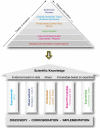From the EBM pyramid to the Greek temple: a new conceptual approach to Guidelines as implementation tools in mental health
- PMID: 28290273
- PMCID: PMC6998697
- DOI: 10.1017/S2045796016000767
From the EBM pyramid to the Greek temple: a new conceptual approach to Guidelines as implementation tools in mental health
Abstract
Guideline methods to develop recommendations dedicate most effort around organising discovery and corroboration knowledge following the evidence-based medicine (EBM) framework. Guidelines typically use a single dimension of information, and generally discard contextual evidence and formal expert knowledge and consumer's experiences in the process. In recognition of the limitations of guidelines in complex cases, complex interventions and systems research, there has been significant effort to develop new tools, guides, resources and structures to use alongside EBM methods of guideline development. In addition to these advances, a new framework based on the philosophy of science is required. Guidelines should be defined as implementation decision support tools for improving the decision-making process in real-world practice and not only as a procedure to optimise the knowledge base of scientific discovery and corroboration. A shift from the model of the EBM pyramid of corroboration of evidence to the use of broader multi-domain perspective graphically depicted as 'Greek temple' could be considered. This model takes into account the different stages of scientific knowledge (discovery, corroboration and implementation), the sources of knowledge relevant to guideline development (experimental, observational, contextual, expert-based and experiential); their underlying inference mechanisms (deduction, induction, abduction, means-end inferences) and a more precise definition of evidence and related terms. The applicability of this broader approach is presented for the development of the Canadian Consensus Guidelines for the Primary Care of People with Developmental Disabilities.
Keywords: Evidence-based psychiatry; clinical guidelines; complexity; framing of scientific knowledge; implementation; intellectual developmental disorders; quality assessment.
Figures
References
-
- Alper BS, Haynes RB (2016). EBHC Pyramid 5.0 for accessing preappraised evidence and guidance. Evidence based Medicine 21, 123–125. - PubMed
-
- Bertelli MO, Munir K, Harris J, Salvador-Carulla L (2016a). Intellectual developmental disorders: reflections on the international consensus document for redefining. mental retardation-intellectual disability in ICD-11. Advances in Mental Health and Intellectual Disability 10(1), 36–58. - PMC - PubMed
-
- Bingeman E (2016). Evaluating normative epistemic frameworks in medicine: EBM and casuistic medicine. Journal of Evaluation in Clinical Practice 22(4), 490–495. - PubMed
Publication types
MeSH terms
LinkOut - more resources
Full Text Sources
Other Literature Sources
Medical


